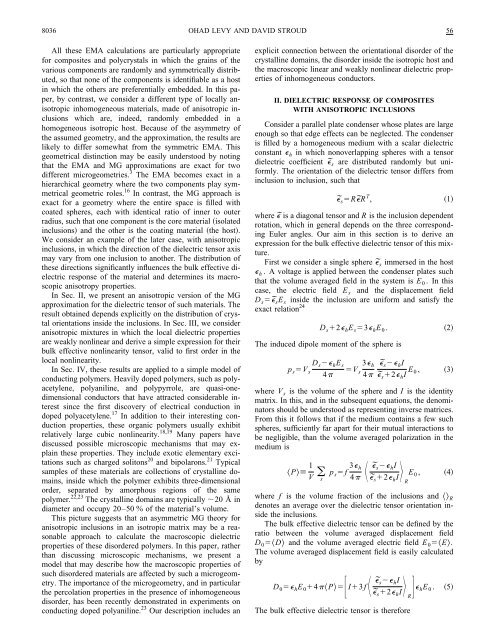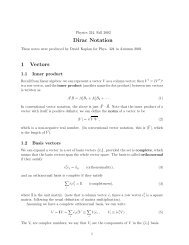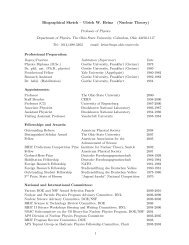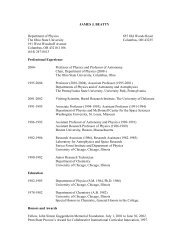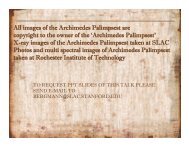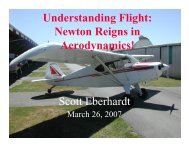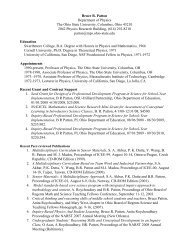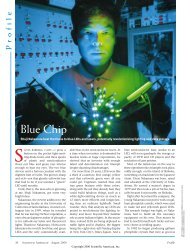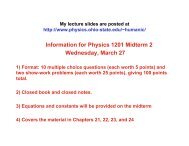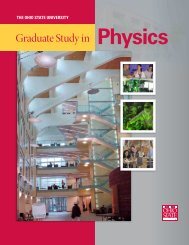Maxwell Garnett theory for mixtures of anisotropic inclusions ...
Maxwell Garnett theory for mixtures of anisotropic inclusions ...
Maxwell Garnett theory for mixtures of anisotropic inclusions ...
You also want an ePaper? Increase the reach of your titles
YUMPU automatically turns print PDFs into web optimized ePapers that Google loves.
8036 OHAD LEVY AND DAVID STROUD<br />
56<br />
All these EMA calculations are particularly appropriate<br />
<strong>for</strong> composites and polycrystals in which the grains <strong>of</strong> the<br />
various components are randomly and symmetrically distributed,<br />
so that none <strong>of</strong> the components is identifiable as a host<br />
in which the others are preferentially embedded. In this paper,<br />
by contrast, we consider a different type <strong>of</strong> locally <strong>anisotropic</strong><br />
inhomogeneous materials, made <strong>of</strong> <strong>anisotropic</strong> <strong>inclusions</strong><br />
which are, indeed, randomly embedded in a<br />
homogeneous isotropic host. Because <strong>of</strong> the asymmetry <strong>of</strong><br />
the assumed geometry, and the approximation, the results are<br />
likely to differ somewhat from the symmetric EMA. This<br />
geometrical distinction may be easily understood by noting<br />
that the EMA and MG approximations are exact <strong>for</strong> two<br />
different microgeometries. 3 The EMA becomes exact in a<br />
hierarchical geometry where the two components play symmetrical<br />
geometric roles. 16 In contrast, the MG approach is<br />
exact <strong>for</strong> a geometry where the entire space is filled with<br />
coated spheres, each with identical ratio <strong>of</strong> inner to outer<br />
radius, such that one component is the core material isolated<br />
<strong>inclusions</strong> and the other is the coating material the host.<br />
We consider an example <strong>of</strong> the later case, with <strong>anisotropic</strong><br />
<strong>inclusions</strong>, in which the direction <strong>of</strong> the dielectric tensor axis<br />
may vary from one inclusion to another. The distribution <strong>of</strong><br />
these directions significantly influences the bulk effective dielectric<br />
response <strong>of</strong> the material and determines its macroscopic<br />
anisotropy properties.<br />
In Sec. II, we present an <strong>anisotropic</strong> version <strong>of</strong> the MG<br />
approximation <strong>for</strong> the dielectric tensor <strong>of</strong> such materials. The<br />
result obtained depends explicitly on the distribution <strong>of</strong> crystal<br />
orientations inside the <strong>inclusions</strong>. In Sec. III, we consider<br />
<strong>anisotropic</strong> <strong>mixtures</strong> in which the local dielectric properties<br />
are weakly nonlinear and derive a simple expression <strong>for</strong> their<br />
bulk effective nonlinearity tensor, valid to first order in the<br />
local nonlinearity.<br />
In Sec. IV, these results are applied to a simple model <strong>of</strong><br />
conducting polymers. Heavily doped polymers, such as polyacetylene,<br />
polyaniline, and polypyrrole, are quasi-onedimensional<br />
conductors that have attracted considerable interest<br />
since the first discovery <strong>of</strong> electrical conduction in<br />
doped polyacetylene. 17 In addition to their interesting conduction<br />
properties, these organic polymers usually exhibit<br />
relatively large cubic nonlinearity. 18,19 Many papers have<br />
discussed possible microscopic mechanisms that may explain<br />
these properties. They include exotic elementary excitations<br />
such as charged solitons 20 and bipolarons. 21 Typical<br />
samples <strong>of</strong> these materials are collections <strong>of</strong> crystalline domains,<br />
inside which the polymer exhibits three-dimensional<br />
order, separated by amorphous regions <strong>of</strong> the same<br />
polymer. 22,23 The crystalline domains are typically 20 Å in<br />
diameter and occupy 20–50 % <strong>of</strong> the material’s volume.<br />
This picture suggests that an asymmetric MG <strong>theory</strong> <strong>for</strong><br />
<strong>anisotropic</strong> <strong>inclusions</strong> in an isotropic matrix may be a reasonable<br />
approach to calculate the macroscopic dielectric<br />
properties <strong>of</strong> these disordered polymers. In this paper, rather<br />
than discussing microscopic mechanisms, we present a<br />
model that may describe how the macroscopic properties <strong>of</strong><br />
such disordered materials are affected by such a microgeometry.<br />
The importance <strong>of</strong> the microgeometry, and in particular<br />
the percolation properties in the presence <strong>of</strong> inhomogeneous<br />
disorder, has been recently demonstrated in experiments on<br />
conducting doped polyaniline. 23 Our description includes an<br />
explicit connection between the orientational disorder <strong>of</strong> the<br />
crystalline domains, the disorder inside the isotropic host and<br />
the macroscopic linear and weakly nonlinear dielectric properties<br />
<strong>of</strong> inhomogeneous conductors.<br />
II. DIELECTRIC RESPONSE OF COMPOSITES<br />
WITH ANISOTROPIC INCLUSIONS<br />
Consider a parallel plate condenser whose plates are large<br />
enough so that edge effects can be neglected. The condenser<br />
is filled by a homogeneous medium with a scalar dielectric<br />
constant h in which nonoverlapping spheres with a tensor<br />
dielectric coefficient ˜ s are distributed randomly but uni<strong>for</strong>mly.<br />
The orientation <strong>of</strong> the dielectric tensor differs from<br />
inclusion to inclusion, such that<br />
˜ sR˜R T , 1<br />
where ˜ is a diagonal tensor and R is the inclusion dependent<br />
rotation, which in general depends on the three corresponding<br />
Euler angles. Our aim in this section is to derive an<br />
expression <strong>for</strong> the bulk effective dielectric tensor <strong>of</strong> this mixture.<br />
First we consider a single sphere ˜ s immersed in the host<br />
h . A voltage is applied between the condenser plates such<br />
that the volume averaged field in the system is E 0 . In this<br />
case, the electric field E s and the displacement field<br />
D s˜ sE s inside the inclusion are uni<strong>for</strong>m and satisfy the<br />
exact relation 24<br />
D s2 hE s3 hE 0 . 2<br />
The induced dipole moment <strong>of</strong> the sphere is<br />
p sV s<br />
Ds hE s<br />
4<br />
V 3 h ˜ s hI<br />
s<br />
4 ˜ s2 hI E0 , 3<br />
where V s is the volume <strong>of</strong> the sphere and I is the identity<br />
matrix. In this, and in the subsequent equations, the denominators<br />
should be understood as representing inverse matrices.<br />
From this it follows that if the medium contains a few such<br />
spheres, sufficiently far apart <strong>for</strong> their mutual interactions to<br />
be negligible, than the volume averaged polarization in the<br />
medium is<br />
P 1<br />
V s<br />
ps f 3 h<br />
4 ˜ s hI<br />
E0 , 4<br />
˜ s2 hI R<br />
where f is the volume fraction <strong>of</strong> the <strong>inclusions</strong> and R<br />
denotes an average over the dielectric tensor orientation inside<br />
the <strong>inclusions</strong>.<br />
The bulk effective dielectric tensor can be defined by the<br />
ratio between the volume averaged displacement field<br />
D 0D and the volume averaged electric field E 0E.<br />
The volume averaged displacement field is easily calculated<br />
by<br />
D 0 hE 04P I3 f ˜ s hI<br />
˜ s2 hI R hE 0 . 5<br />
The bulk effective dielectric tensor is there<strong>for</strong>e


